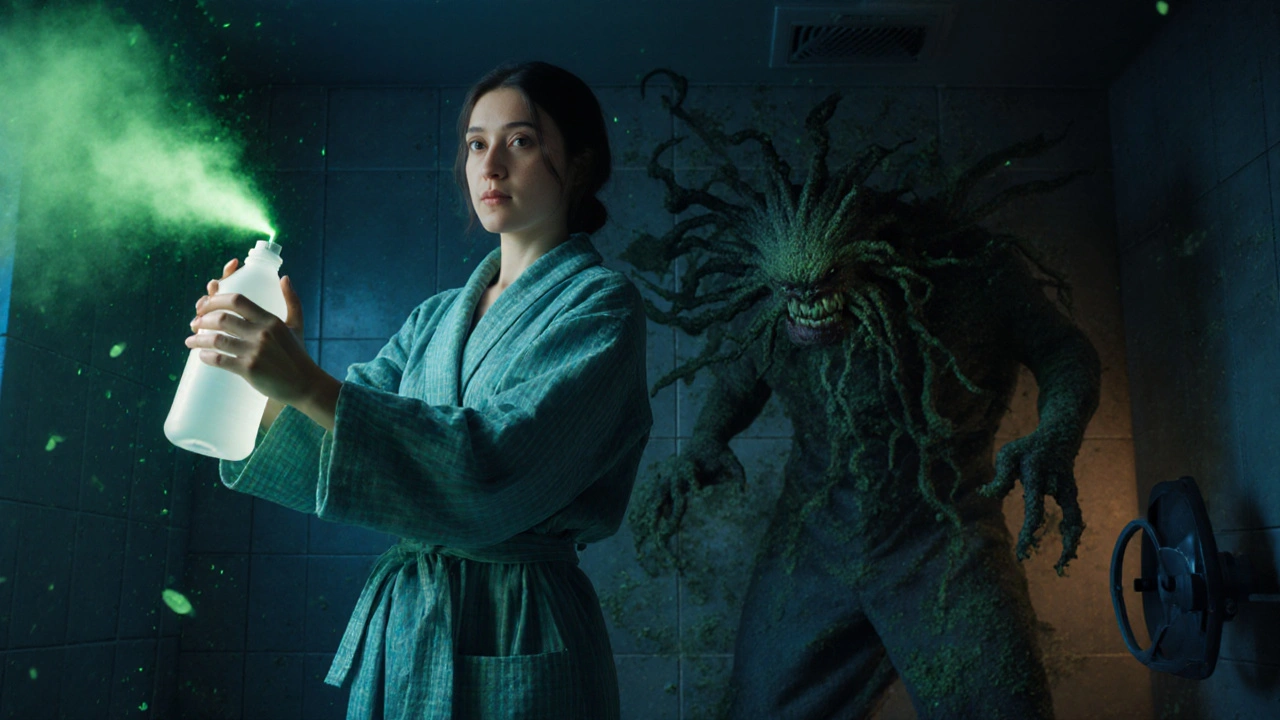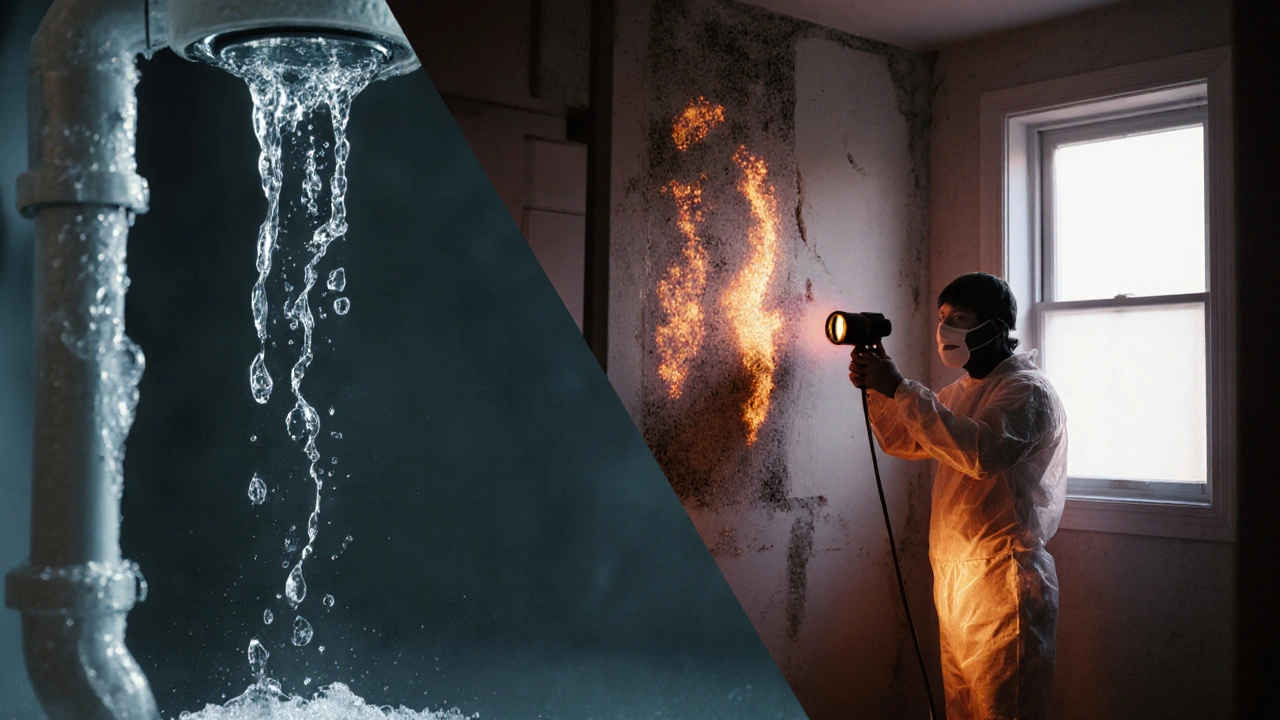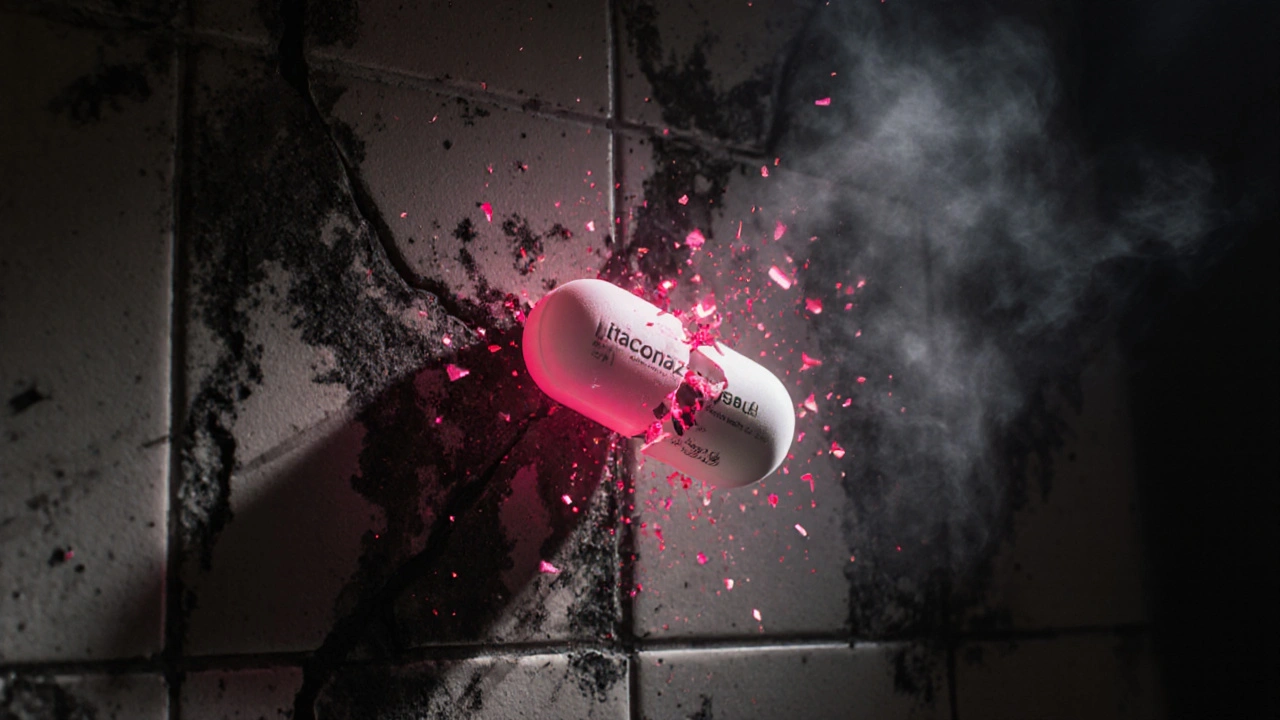Most people think of itraconazole as a pill for toenail fungus or a lung infection. But if you’ve ever stared at black streaks creeping up your bathroom grout or smelled that damp, musty odor no air freshener can kill, you might be wondering: itraconazole could actually help with mold and mildew in your home. Is that true? And if so, should you be using it?
The short answer: no, you should not spray itraconazole on your walls.
Itraconazole is an antifungal medication approved by the FDA for treating internal fungal infections in humans and animals. It works by disrupting the cell membranes of fungi like Aspergillus and Candida. But mold and mildew growing on your shower curtain? Those are environmental fungi - not infections inside your body. Using a prescription drug meant for internal use as a household cleaner is dangerous, ineffective, and illegal.
Why itraconazole doesn’t work on home mold
Mold spores thrive on organic material: drywall, wood, fabric, even soap scum. They grow in damp, dark places because they’re not trying to infect you - they’re trying to digest your wallpaper. Itraconazole doesn’t kill mold spores on surfaces. It’s designed to be absorbed into your bloodstream, travel to infected tissues, and interfere with fungal cell growth from the inside out.
Even if you could somehow spray itraconazole solution on your walls (and you absolutely shouldn’t), it wouldn’t penetrate deep enough to kill the root structures of mold. Mold doesn’t just sit on the surface - it sends hyphae deep into porous materials. Surface sprays, even strong ones like bleach, often fail to reach them. Itraconazole? It’s even less suited for the job.
Plus, itraconazole isn’t stable in water or sunlight. Left in a spray bottle, it breaks down quickly. You’d need to mix it fresh every time, store it in the dark, and keep it refrigerated - all while risking accidental ingestion or skin exposure. There’s no scientific study, no EPA registration, and no manufacturer recommendation that supports using itraconazole as a home antifungal spray.
What actually works for mold and mildew
Real mold control doesn’t need a prescription. It needs action, ventilation, and the right cleaners.
- For non-porous surfaces (tile, glass, metal): Use a mix of 1 cup bleach to 1 gallon of water. Scrub, rinse, dry. Bleach kills surface mold but won’t touch roots in drywall.
- For porous surfaces (drywall, ceiling tiles, carpet): If mold has soaked in, remove and replace the material. No cleaner will fully eliminate it.
- For bathrooms and kitchens: Keep humidity below 50%. Use exhaust fans during and after showers. Wipe down wet surfaces daily. A dehumidifier helps in basements.
- For stubborn mildew: White vinegar (undiluted) sprayed on and left for an hour works better than many commercial products. It’s non-toxic, cheap, and kills 82% of mold species according to the EPA.
Some people turn to tea tree oil, hydrogen peroxide, or commercial mold removers like Concrobium. These can help with surface cleaning, but none of them stop mold from coming back if the moisture problem isn’t fixed.
The real problem: moisture, not mold
Mold is a symptom. The real issue is water.
Leaky pipes. Condensation on windows. Poor attic ventilation. A cracked foundation. A clogged gutter. These are the causes. Mold is just the visible sign.
If you treat the mold but not the water, it will return - often worse than before. That’s why professionals always start with a moisture assessment. They use hygrometers to measure humidity, infrared cameras to find hidden leaks, and moisture meters to check wall integrity.
Fixing a dripping faucet or sealing a gap around your shower base might cost $50. Hiring a mold remediation company to spray chemicals on your walls? That can run $2,000-$6,000. The cheapest solution is always the one that stops water before it gets to the mold.

When to call a professional
You don’t need to panic over a few spots of mildew. But if you see any of these, it’s time to call someone:
- Mold covering more than 10 square feet
- Mold behind walls or under floors
- Black, fuzzy patches that keep coming back
- Respiratory issues in your household that worsen at home
- Water damage from flooding or roof leaks
Professional remediators use HEPA vacuums, negative air machines, and antimicrobial sealants approved for building materials. They follow EPA and IICRC guidelines. They don’t use prescription antifungals. They fix the source.
Why people think itraconazole might work
There’s a dangerous myth floating around online: if itraconazole kills fungus inside the body, it must kill fungus on the walls too. This is like saying if antibiotics cure a throat infection, you can gargle them to clean your sink.
Some blogs and YouTube videos show people mixing itraconazole pills with water and spraying it on their showers. They claim it “cleared up their mold.” But what they’re likely seeing is a temporary suppression of surface growth - not elimination. Mold can lie dormant for months. Without fixing the moisture, it returns.
Worse, some users report nausea, headaches, or liver pain after using it this way. Itraconazole is metabolized by the liver. Repeated skin exposure or accidental inhalation can stress your system. The FDA has issued warnings about off-label use of antifungals - especially when taken without medical supervision.

What you should do instead
Here’s a simple, safe, and effective plan:
- Identify the source of moisture. Check pipes, windows, roofs, and ventilation.
- Fix leaks. Replace broken seals. Install or clean exhaust fans.
- Use a dehumidifier in damp areas. Keep humidity below 50%.
- Clean visible mold with vinegar or diluted bleach. Wear gloves and a mask.
- Remove and replace porous materials if mold is deep or widespread.
- Monitor regularly. Take photos every month to track changes.
For recurring problems, consider a mold test kit from a hardware store. They cost under $30 and can tell you if you’re dealing with Aspergillus, Cladosporium, or Stachybotrys - the black mold linked to serious health risks.
Final thoughts
Itraconazole is a powerful drug. It saves lives when used correctly for internal fungal infections. But it has no place in your cleaning cabinet. Using it to fight mold is not a shortcut. It’s a risk with no benefit.
Mold is frustrating. It’s ugly. It smells bad. But it’s not a medical problem you can treat with pills. It’s a home maintenance issue - and the solution is simpler than you think: dry it out, clean it up, and keep it that way.
If you’ve been tempted to try itraconazole on your walls - stop. Your health, your home, and your wallet will thank you.
Can itraconazole be used to kill mold on walls?
No. Itraconazole is an oral antifungal medication designed to treat internal fungal infections. It is not formulated, tested, or approved for surface application. Spraying it on walls won’t kill mold roots and poses health risks from skin exposure or accidental ingestion.
Is it safe to mix itraconazole with water and spray it?
No. Mixing itraconazole with water creates an unstable solution that degrades quickly. It offers no proven benefit against mold and can cause skin irritation, respiratory issues, or liver stress if inhaled or absorbed. The FDA warns against off-label use of antifungal drugs outside medical supervision.
What’s the best way to remove mold from a bathroom?
For non-porous surfaces like tile or glass, use undiluted white vinegar or a 1:10 bleach solution. Scrub, rinse, and dry completely. For porous materials like drywall or grout with deep mold, removal and replacement are the only reliable options. Always fix the moisture source first.
Does itraconazole kill black mold?
Itraconazole is not effective against black mold on surfaces. While it can treat systemic infections caused by Stachybotrys or Aspergillus inside the body, it does not penetrate or destroy mold colonies growing on walls, ceilings, or wood. Surface mold requires physical removal and moisture control.
Can mold exposure make you sick even if you don’t see it?
Yes. Mold can grow hidden behind walls, under floors, or inside HVAC systems. Exposure to mold spores can cause allergic reactions, asthma flare-ups, coughing, and sinus infections - even without visible growth. If you smell a musty odor or have unexplained respiratory symptoms, consider a professional inspection.



14 Comments
Lugene Blair October 29, 2025 AT 05:29
Just saw someone on TikTok spraying crushed itraconazole pills on their shower walls-my jaw hit the floor. You don’t treat a leaky pipe with a prescription. Fix the water, not the symptom. This post is a godsend.
William Cuthbertson October 31, 2025 AT 03:43
It’s fascinating, isn’t it, how we so readily anthropomorphize fungi-as if mold has malice, as if it’s some sentient foe we must vanquish with chemical warfare? But no, it’s merely an organism doing what evolution trained it to do: consume, proliferate, endure. We built damp homes, then panicked when the house started digesting itself. The real tragedy isn’t the mold-it’s our refusal to accept that we’re the architects of our own decay.
Eben Neppie October 31, 2025 AT 07:06
Let’s be crystal clear: itraconazole is not a surface disinfectant. It’s a systemic antifungal with hepatic metabolism, a half-life of 24 hours, and FDA warnings against off-label use. Spraying it is not ‘home hacking’-it’s reckless self-medication with potential liver toxicity. The EPA doesn’t register it for surface use because it doesn’t work. End of story. Stop listening to YouTube ‘remediation gurus’ with zero credentials.
Hudson Owen October 31, 2025 AT 13:18
I appreciate the thoroughness of this post. It strikes a rare balance between scientific rigor and accessible advice. Too often, these discussions devolve into fear-mongering or pseudoscientific shortcuts. The emphasis on moisture control as the root cause-rather than the visible mold-is not just correct, it’s essential. Thank you for grounding this in evidence, not anecdote.
Steven Shu October 31, 2025 AT 19:47
White vinegar works better than bleach for most cases, and it won’t destroy your grout or release toxic fumes. I’ve used it for years. Just spray, wait an hour, scrub, and dry. No gloves needed. Cheap, safe, and effective. Why are people still buying $40 mold sprays?
Anna S. November 1, 2025 AT 17:31
Wow, so you’re telling me I shouldn’t just crush my antifungal pills and spray them like some kind of DIY wizard? I mean, come on, if it kills fungus in my toenails, why wouldn’t it kill it on the wall? I’m just trying to save money here. But okay, I guess I’m a dumbass now. Whatever.
Yaseen Muhammad November 3, 2025 AT 16:35
Excellent breakdown. In India, we’ve long used neem oil and turmeric paste for mildew in humid homes-natural, accessible, and non-toxic. The principle remains the same: reduce moisture, clean surface, prevent recurrence. No magic pills needed. Science and tradition agree here.
Sam Tyler November 3, 2025 AT 17:41
There’s something deeply human about our obsession with quick fixes-especially when it comes to things we can’t control. Mold grows in the dark corners of our homes, just like anxiety grows in the dark corners of our minds. We want a spray, a pill, a button to press-and we’ll believe anything that promises it. But real peace comes not from killing the mold, but from fixing the leak. That’s the hard work. That’s the real healing.
shridhar shanbhag November 4, 2025 AT 23:21
My uncle in Kerala used to scrub mold with lime and salt. No chemicals. No pills. Just old-school wisdom. Works every time if you keep the place dry. People forget: nature doesn’t need pharmaceuticals to clean itself. We just need to stop making messes.
John Dumproff November 5, 2025 AT 05:13
I used to panic every time I saw a black spot. Then I learned it’s not about eradication-it’s about management. I keep a dehumidifier running in my basement, wipe down the shower after every use, and use vinegar once a week. No more mold. No more stress. Simple habits > expensive solutions.
Milind Caspar November 5, 2025 AT 15:44
Let me ask you this: if itraconazole isn’t approved for surface use, why are pharmaceutical companies still patenting antifungal coatings for building materials? Why do hospitals use systemic antifungals in HVAC systems during outbreaks? The truth is being hidden. The EPA, the FDA-they’re all in bed with bleach manufacturers. Mold is a billion-dollar industry, and you’re being sold a lie. Don’t be fooled.
Rose Macaulay November 6, 2025 AT 15:35
I tried the vinegar thing last month and it actually worked. Like, shockingly well. I was ready to tear out my grout, but one spray and a scrub and it was gone. No smell, no fumes, no panic. Honestly, why does anyone even buy those expensive sprays?
Ellen Frida November 7, 2025 AT 05:14
ok so i just read this whole thing and i think maybe mold is like a sign from the universe? like maybe its telling us to change our lives? i mean, why else would it keep coming back? i think its about more than just water… its about energy. and maybe itraconazole is a metaphor? idk i just feel like we’re missing the deeper meaning here. also my cat sneezed once near the bathroom so maybe its haunted?
Michael Harris November 8, 2025 AT 08:39
Everyone’s acting like this is some groundbreaking revelation. Newsflash: itraconazole is not a cleaner. We’ve known this since the 90s. The real scandal is how many people still believe this crap. You’re not ‘saving money’-you’re risking liver failure. Stop being lazy and fix your plumbing. Or hire a pro. But don’t turn your bathroom into a pharmaceutical lab.